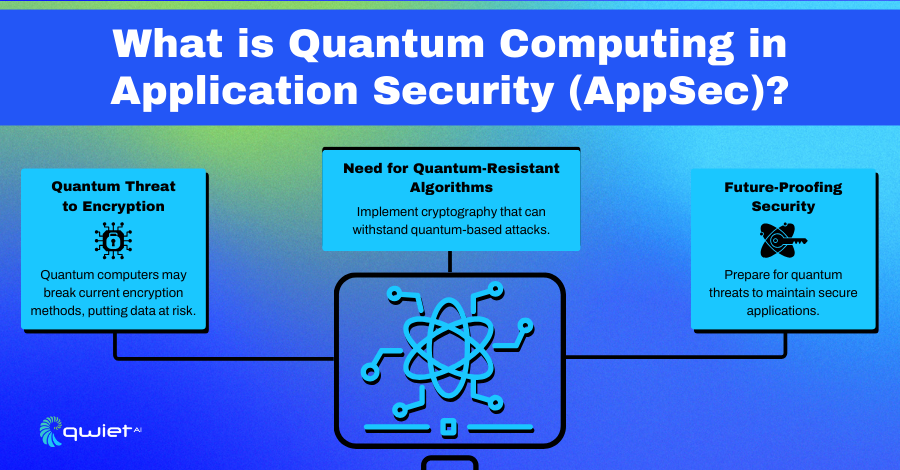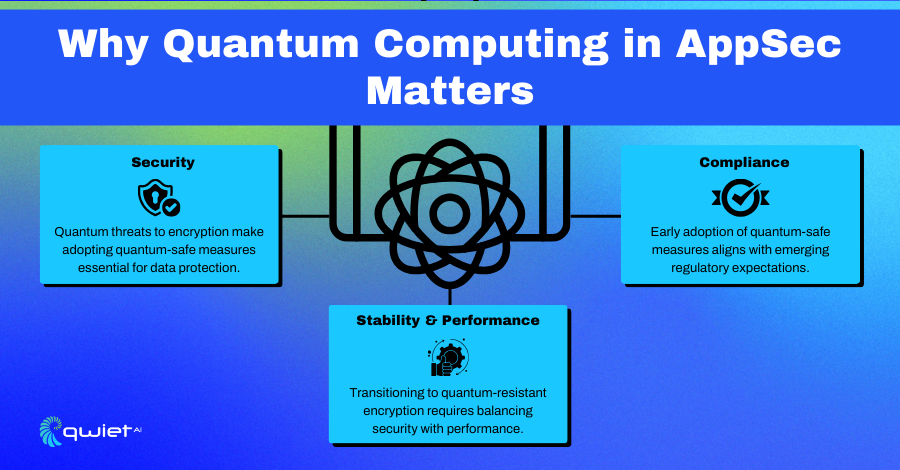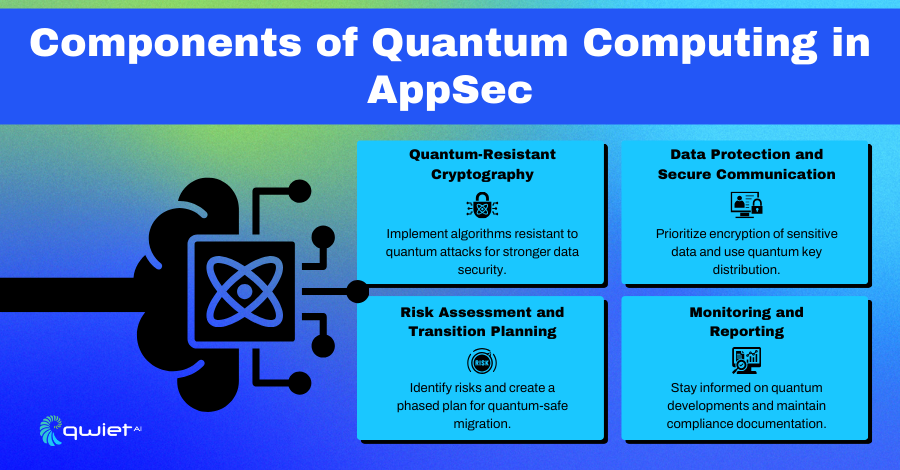What is Quantum Computing in Application Security (AppSec)?

Quantum computing in Application Security (AppSec) considers the potential impact of quantum technology on current security protocols and the development of quantum-resistant defenses. Quantum computers can perform complex calculations exponentially faster than classical computers, posing new encryption and data security challenges. This capability threatens traditional encryption methods that rely on the difficulty of specific mathematical problems, which quantum systems could solve quickly, making existing security methods vulnerable.
AppSec is shifting towards quantum-resistant algorithms that can secure applications against potential quantum-based threats to address these challenges. The objective is to prepare for quantum advancements by strengthening cryptographic measures to ensure that application security frameworks can maintain data confidentiality and withstand quantum computing risks as this technology evolves.
Why Quantum Computing in AppSec Matters

Security
Quantum computers have the potential to compromise widely used encryption standards like RSA and ECC, which underpin secure communications and data storage. These encryption methods rely on complex mathematical problems that quantum systems could solve much faster than classical computers. Without encryption that can resist quantum attacks, sensitive data and critical systems may become vulnerable to decryption by those with access to quantum technology. Adopting quantum-resistant algorithms now can help safeguard against potential breaches, creating a future-ready security posture as quantum capabilities grow.
Stability & Performance
Implementing quantum-resistant cryptographic algorithms may add computational overhead, affecting application performance. Balancing this impact is important to maintain applications’ efficiency as they adopt stronger cryptographic measures. On the other hand, quantum computing can potentially improve optimization and data processing, especially in areas like AI and machine learning. Preparing for quantum’s impact in AppSec means finding ways to secure applications without compromising their stability, ensuring they perform reliably under new encryption protocols.
Compliance
Regulatory bodies will likely begin requiring quantum-safe encryption standards to support long-term data security, particularly for sectors that handle sensitive or critical information. Compliance frameworks, such as GDPR, HIPAA, and PCI-DSS, may evolve to include quantum-resistant measures, making early adoption a forward-looking choice for organizations.
Proactive quantum readiness in AppSec aligns with these emerging compliance needs and reduces the risk of future regulatory challenges as quantum computing technology advances.
Components of Quantum Computing in AppSec

Quantum-Resistant Cryptography
Post-Quantum Algorithms:
Applications need encryption methods that resist quantum-based attacks to prepare for quantum computing’s impact on security. Post-quantum algorithms like lattice-based, hash-based, and code-based cryptography are promising options. These algorithms are specifically designed to withstand the processing power of quantum computers, adding a layer of protection that conventional algorithms cannot provide in a quantum-enabled future.
Key Management:
Quantum-resistant keys tend to be larger and more complex, requiring changes in key management practices. Updating key management practices to accommodate these new, quantum-safe keys is essential for maintaining efficient and secure encryption processes. Adjusting existing systems for these requirements will help support a smoother transition to quantum-resistant cryptography.
Data Protection and Secure Communication
Quantum Key Distribution (QKD):
Quantum Key Distribution (QKD) is a quantum-based method that enables the secure exchange of encryption keys, even in the presence of a quantum-enabled adversary. QKD uses the principles of quantum mechanics to protect keys during transmission, providing a highly secure way to maintain data confidentiality. Integrating QKD can future-proof secure communications against the risks posed by quantum computing.
Encrypting Sensitive Data:
Quantum computing could potentially decrypt data that is currently considered secure. Encrypting sensitive or long-term data with quantum-resistant algorithms is important in preparing for future quantum risks. Prioritizing this data now reduces the chances of unauthorized access or decryption by advanced quantum systems.
Risk Assessment and Transition Planning
Assessing Quantum Risk:
Understanding the vulnerabilities that quantum computing may expose is a valuable step in preparing applications for a secure future. Conducting a risk assessment helps identify systems that rely on encryption methods potentially at risk from quantum attacks, allowing teams to address these areas with quantum-safe solutions.
Phased Transition:
Transitioning to quantum-safe cryptography doesn’t have to happen all at once. A phased transition plan allows organizations to move from current cryptographic methods to quantum-resistant algorithms gradually. This approach minimizes operational disruptions and provides time for testing and adjustments, helping maintain security and performance throughout the transition.
Monitoring and Reporting
Continuous Monitoring of Quantum Advancements:
Keeping an eye on developments in quantum computing is important for staying informed of any new security challenges or advancements. Regular monitoring enables security teams to adapt their strategies as quantum technology evolves, ensuring their AppSec practices align with the latest quantum-resistant innovations.
Documentation and Compliance Reporting:
As quantum readiness becomes a security focus, documenting the steps taken toward quantum preparedness will support compliance and regulatory needs in the future. Comprehensive records of these preparations demonstrate a proactive approach to quantum security, which can be invaluable in maintaining a secure application environment and meeting evolving regulatory expectations.
Conclusion
Quantum computing is set to transform application security, and preparing for this shift is a proactive step toward future-proofing your systems. There’s much to consider, from implementing quantum-resistant cryptography to planning for secure data communications. Qwiet AI can guide you through these evolving security needs, ensuring your applications remain resilient against current and emerging threats. Book a call with the Qwiet AI team today to explore how we can help you stay ahead in application security, ready for the quantum future and beyond.
Read Next
Security Headers
What are Security Headers? Security headers are tools web servers use to protect web applications by dictating how browsers should behave when handling a website’s content. These headers enhance security by preventing common vulnerabilities like cross-site scripting (XSS), clickjacking, and other code injection attacks. By specifying certain policies directly in the HTTP response headers, web […]
Zero Trust Architecture Overview
What is Zero Trust Architecture? Zero Trust Architecture (ZTA) is a security framework that assumes no user or device is inherently trustworthy. It eliminates the concept of a secure perimeter by applying strict verification to every resource interaction, treating all access requests as potentially malicious. ZTA continuously validates user and device identities, regardless of location, […]
Data Encryption
Introduction Have you ever wondered how your private info stays safe online? In a world where cyber threats are rising and we share more data than ever, data encryption is our digital guardian angel. This article will take you through how encryption works to protect your information and why it’s more important now than ever. […]